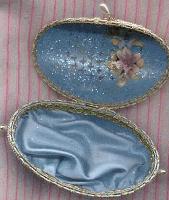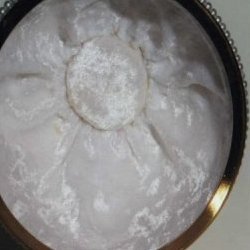LINING AN EGG
From Maureen WilliamsUse either satiny or velvet fabric. Measure the inside of the egg from top edge to the bottom and back to the top edge and add an inch. We'll say it measure 5 inches, so we will cut a circle of 6 inches across. With a needle and thread make small stiches over and under about 1/8 of an inch from the edge all around the circle. Place a pin to mark the outer edge of the circle in 4 equal spaces. place a band of glue around the inside top of the egg. With the thread, draw the fabric into gathers equally spaced between the pins. Starting in the back, press gathered fabric in place. You can use some small pinch clothspins to hold the fabric in place to let dry. Do the same to the front, then the two sides. press the fabric in place equally spaced all around the top edge. When dry, pull the thread out, the rest of the fabric will stay loose. Glue a fancy gold braid along the inside top edge of the egg to hide the edges of the fabric. You can do the same with the top section.

This jewel box made by Betty Bruce ~~~~~~~~~ from Michele Jeffries An ostrich egg was used. It was cut in half for a hinge ring. The fabric used for the lining was a light, stretch velvet in white.
A touch-n-play (music box) was also added.
The steps are:

Here's an example of a push and play music box in the lining ~~~~~~~~~ From Phyllis....... I read with interest how you line your eggs. I like more fullness for lovely drapes and I do it differently. In the bottom of my eggs, I sprinkle BB pellets or shot weights and pour Elmers glue through them so none is loose. Let it dry completely and then put a little cotton batting over the BB's. (for padding) Then I line the egg. I never let the edge of the fabric ravel. I use a drape stick (or a ceramic needle tool) and do not sew the edges and draw up. I mark the fabric in 4 sections to line it up and start with the drape stick to tack the fabric around the egg. Took awhile to master the drape stick but it is faster than the sewing. To each his own. Just the method taught to me. The BB's give weight and stability to the egg. I scrape the edges of the inside of the egg clear of membrane as the membrane will dry out later and take the lining loose. About 1/8th down from the edge, I put a bead of glue (elmers or 527 are favorites of mine) Using the drape stick, or a ceramic needle tool, I start tucking the fabric into place moving the material into folds and gathers. Small clothespins hold it all in place while it dries. I do not turn the edge of the fabric under. I cover the raw edges with trim. |